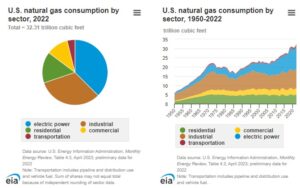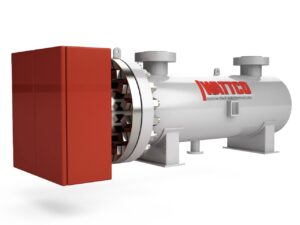Preheaters of Natural Gas
Last updated on April 21st, 2025 at 02:59 pm
Natural gas is one of the most commonly used fossil fuel and a nonrenewable source of energy. It is mainly composed of two elements, Carbon and Hydrogen. The natural gas cannot be used as a fuel in its natural form. It needs to be processed and have its impurities removed, to be used for domestic and industrial purposes.
Uses of Natural Gas
Being the third largest source of energy, natural gas is used for a variety of purposes. The fact that it is an environmentally friendly fuel makes it a popular choice amongst industries and domestics alike. Here is how natural gas is used for a multitude of purposes:
- Industrial Uses: as an ingredient of glue, detergent, fertilizer and paint.
- Residential Uses: for stoves, fireplaces, ovens, heating homes and outdoor lighting.
- Electric Utilities Uses: to generate electricity.
- Commercial Uses: for cooking and heating.
- Transportation Uses: as a fuel for cars and other vehicles
Transporting Natural Gas through Pipelines
Transporting natural gas is not an easy task. The safest way of transporting it is through pipelines. With an efficient network of pipelines, natural gas can easily be transported from the area of origin to the area of demand.
Pipeline transportation of natural gas requires it to travel under high pressure. Usually the pressure levels of 200 to 1500 pounds per square inch (psi) are needed to transmit natural gas. The natural gas needs to be at such high pressures for two reasons:
- It helps reduce the volume by up to 600 times
- It helps drive the natural gas forward along the distant pipelines
However, the natural gas cannot be provided to domestic and industrial users through the local gas distribution network at such high pressures. The pressures of the gas need to be brought down tremendously to 3 psi or 0.25 psi to be able to use locally. The regulators at the beginning of distribution networks control the pressure of the gas and ensure that optimal flow rate is maintained to reach customers and fuel their appliances.
Preheating Of Natural Gas
 The reduction of natural gas pressure before distributing it to consumers also causes a drop in temperature. For example, if the pressure of the natural gas is reduced by 88%, the temperature will drop by almost 65%. In terms of physics, this is known as the Joule Thompson effect.
The reduction of natural gas pressure before distributing it to consumers also causes a drop in temperature. For example, if the pressure of the natural gas is reduced by 88%, the temperature will drop by almost 65%. In terms of physics, this is known as the Joule Thompson effect.
This drop in temperature can create operational and material quality problems in the distribution networks. The water vapor dew point falls and causes icing within and outside the pipelines.
This brings in the necessity of preheating the natural gas before the pressure reduction. Heating the gas before transmission can overcome this Joule Thompson effect. The preheating of natural gas causes the temperature of the gas to rise enough so that after pressure throttling and temperature reduction, it reaches the optimal required temperature.
Natural Gas Preheaters
Electrical Block Type Process Heaters
Electrical process heaters can be used to prevent the Joule Thompson effect. These heaters use indirect electric heating to raise the temperature of the natural gas. The heater is made up of an aluminum encased heating bundle and tube coil. The gas flows through the coil and is heated up, through the heat transfer, by the aluminum encasing. The aluminum block is protected by the stainless steel or carbon shell.
Heat Exchangers
Heater exchangers such as circulation heaters, are one of the best ways to heat up natural gas before transmission. These heat exchangers use steam or hot water as a thermal carrier fluid. The design of the thermal exchanger is such that the gas flows along a tube plate where it meets the hot water or steam through a set of diaphragms for heat exchange.
The thermal carrier is flown from the top of the exchanger through the tubes to the bottom where it leaves via an outlet. The design is such that natural gas is exposed to the thermal carrier for the maximum possible time for optimal heat exchange.
Types of thermal carriers used depend on the heat capacities required.
- Hot water natural convection – for 45000 Kcal/h (maximum)
- Hot water forced convection – for 750 000 Kcal/h (maximum)
- Steam – for 750 000 Kcal/h (maximum). Care should be taken that steam pressure does not exceed 2 absolute bars and 120 degrees Centigrade.
Also read: Kettle Reboiler- heat exchangers
Studies suggest that it requires almost 22kJ to heat up a kilogram of natural gas to 16.5 degree Centigrade before reducing its pressure so that the gas temperature drops down to only 10 degree Centigrade.
Natural gas is a widely used fossil fuel, employed for domestic and industrial purposes alike. The safest way to transport it is through pipelines at high-pressure values. Before transmitted along the local distribution networks, this pressure needs to be reduced. A severe drop in pressure can lead to an equally severe drop in temperature.
This reduction in temperature is not ideal and therefore, natural gas should be heated before transmission so that its temperature value does not fall below acceptable levels after pressure throttling. Electrical block type heaters and heat exchangers are two of the commonly used heating devices for the preheating of natural gas.
